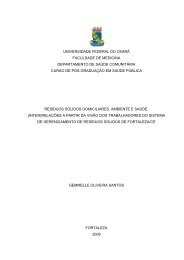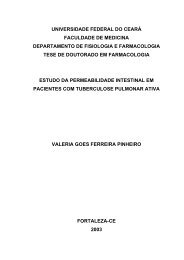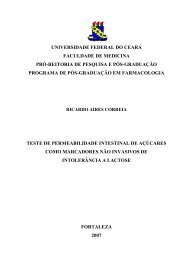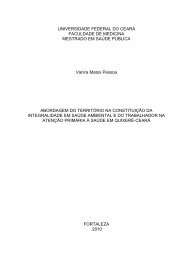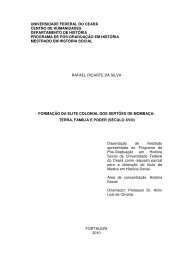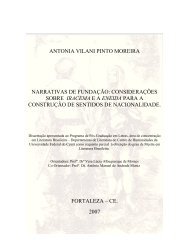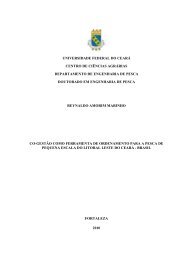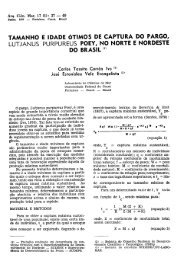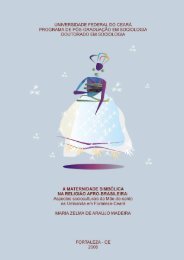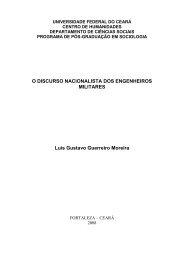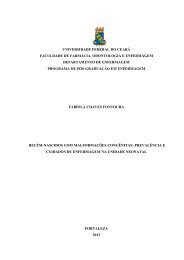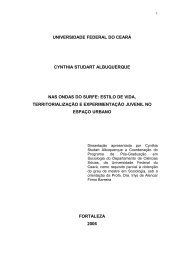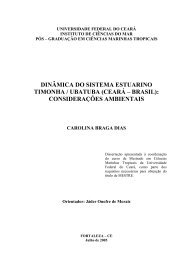Tungíase: doença negligenciada causando patologia grave
Tungíase: doença negligenciada causando patologia grave
Tungíase: doença negligenciada causando patologia grave
Create successful ePaper yourself
Turn your PDF publications into a flip-book with our unique Google optimized e-Paper software.
438 Feldmeier et al<br />
lymph nodes were palpated for the presence of<br />
swelling and pain (lymphadenitis).<br />
To determine the severity of infestation, the body<br />
was divided into two halves (right and left). Each half<br />
was subdivided into 16 areas: interdigital spaces,<br />
hand, wrist, arm, elbow, axilla, leg (excluding the<br />
medial area of the thigh), foot, abdomen, ventral<br />
thorax, mamillar/perimammilar area, back, buttocks,<br />
genitals, inguinal area/medial area of the thigh, and<br />
head (scalp/neck/face). Thus, the number of affected<br />
areas possibly ranged from 0 to 32. Severe<br />
scabies was arbitrarily defined as the presence of 12<br />
or more infested topographic areas. 10<br />
Illiteracy was defined as the inability to read and<br />
write more than one’s own name.<br />
Data storage and analysis<br />
Data were entered twice into a database using a<br />
software package (Epi Info, Version 6.04d, Centers<br />
for Disease Control and Prevention, Atlanta, GA) and<br />
checked for errors that may have occurred during<br />
their entry. Then, data were transferred to another<br />
software package (Stata, Version 9.0, Stata Corp,<br />
College Station, TX) for analysis. Fisher exact test was<br />
used to determine the significance of differences of<br />
relative frequencies. For the identification of possible<br />
risk factors, the odds ratios with the respective<br />
95% confidence intervals were calculated.<br />
Three individuals were given a diagnosis of scabies<br />
during the first and the second survey. These<br />
cases were entered into the risk factor analysis only<br />
once. Control subjects were all individuals without<br />
scabies during the first survey plus individuals who<br />
had immigrated into the area after the first survey and<br />
who were without scabies during the second survey.<br />
In a second step multivariate logistic regression<br />
using backward elimination was performed to calculate<br />
adjusted odds ratios for the independent association<br />
between exposure variables and the presence<br />
of scabies. All variables on a significance level of P<br />
less than .2 were included in the multivariate regression<br />
model. Socioeconomic and behavioral variables<br />
were based on households, except sharing of beds,<br />
clothes, and towels, and use of shower and soap.<br />
These exposure variables were entered in the model<br />
on the individual level. Incidence (I ) was calculated<br />
according to the formula I = P/D; where P is the<br />
prevalence and D the average duration of disease. As<br />
the mean duration of scabies in resource-poor settings<br />
is estimated between 2 and 8 months, 2 the<br />
incidence was calculated assuming 2, 6, and 8 months<br />
of disease duration, respectively.<br />
Ethical considerations<br />
The study was approved by the ethical committee<br />
of the Escola de Ciências Médicas de Alagoas, the<br />
JAM ACAD DERMATOL<br />
MARCH 2009<br />
responsible ethical body in Alagoas State, Brazil.<br />
Before the study, meetings were held in the community<br />
with health care workers and community<br />
leaders to explain the objectives. All participants<br />
were informed about the study, and informed written<br />
consent was obtained. In the case of minors, the<br />
guardian was asked for written consent. If patients<br />
were illiterate, the informed consent was read for<br />
them and patients had to sign the informed consent<br />
by their finger print. Any inhabitant of the study area<br />
was free to refrain from participating without any<br />
disadvantage for oneself or other family members.<br />
If other skin diseases were diagnosed during the<br />
examination, patients were referred to the primary<br />
health care center of Feliz Deserto, where all treatment<br />
is free of charge. At the end of the study, mass<br />
treatment of all inhabitants of the village was<br />
performed using ivermectin (2 3 200 g/kg body<br />
weight) to relieve subjects from ectoparasites and<br />
remaining intestinal helminths. Children younger<br />
than 5 years were treated with mebendazole (2 3<br />
100 mg).<br />
RESULTS<br />
In total, 2002 individuals were examined, 1014<br />
during the first survey in the rainy season, and 988<br />
during the second survey in the dry season. This<br />
corresponded to 88.5% and 90.9% of the target<br />
population, respectively. Men disproportionately<br />
accounted for nonparticipants in both surveys.<br />
Boys and young men (15-29 years) often worked<br />
on surrounding farms during the week, where they<br />
stayed from Monday to Friday, and therefore failed to<br />
fulfill the admission criteria of spending 4 nights per<br />
week in the study area.<br />
Of the studied households, 89.3% had access to<br />
electricity, and 81% had toilets on their compounds.<br />
In all, 49.6% of the study members lived in brick-built<br />
houses. Of the households, 83% had more than 4<br />
members and 61.7% had a monthly income of less<br />
than R$200 (the official minimum wage; approximately<br />
US$105). The education level was low: 34.2%<br />
of those aged 15 years or older were illiterate.<br />
During the first door-to-door survey, 102 scabies<br />
cases were detected (10.1%) and during the second,<br />
94 (9.5%; P = .71). Three individuals were given a<br />
diagnosis of scabies during the first and the second<br />
survey, although these cases had been treated at the<br />
end of the first survey. It remained unclear whether<br />
this was a result of drug failure or a reinfestation.<br />
Table I depicts age- and sex-specific prevalence<br />
during the rainy and the dry seasons. The frequency<br />
of scabies and severe scabies, and the proportion of<br />
superinfected lesions (35.3% in the rainy vs 38.3% in<br />
the dry season) were similar in both surveys.



